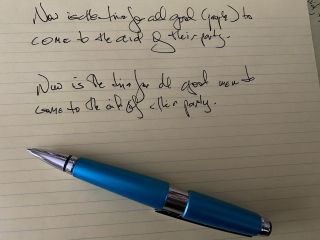Education
Handwringing Over Handwriting
Is cursive a blessing or a curse?
Updated March 14, 2024 Reviewed by Hara Estroff Marano
Key points
- Neuroscience points to benefits of writing by hand.
- Keyboarding is replacing handwriting.
- Playful alternatives to handwriting drills have surprising results.
Handwriting masters in the 19th century, authors of copybooks that tutored styles that ranged from the “coarse” and practical to the florid and elegant, celebrated the character-building virtues of penmanship. Mastering the art of moving a pen trailing ink on paper, learning the smooth, swift, efficient flow of letter to letter in the round “copperplate script” of the day, a meticulous, years-long learning process, was not just practicing a mechanical skill for legible communication. The act of learning to write handsome, fluent calligraphy, in fact, unfolded as a moral exercise.
One such expert, Fielding Schofield, wrote that “the study of penmanship refines our tastes, assists in cultivating our judgment, and makes us better men.”
Reading documents from the mid-1840s to the mid-1920s—correspondence, official papers, and even routine business records—as historians will, is to behold a lost world of care and beauty. Love, too. Personal letters from the time, sometimes over-written crosswise on thin paper to save postage, expressed not just the personal feelings, especially longing, of the writer, but the personality of the writer.
Thereafter and with increasing speed, the widespread adoption of the typewriter deskilled professional scribes and everyday letter writers. The new machines put scriveners out of their jobs. By the late 19th century, trained speed typists (called “typewriters” then) could beat even the fastest shorthand aces, churning out forty or fifty words per minute. Critics and traditionalists, motivated by strong artistic and anti-modern sentiment, called the products of the newfangled machines soulless.
Cursive for Your Brain
Contemporary celebrants of handwriting look to cutting-edge neuroscience for supporting evidence. One recent post on Psychology Today, for example notes that “handwriting stimulates [the genesis of] complex brain connections essential in encoding new information and forming memories.”
Studies employing high-density electroencephalogram technology point to the conclusion that note-takers, grocery-list compilers, and those who make calendar entries by hand are more likely to better retain the information. Entering information by hand also heightened the speed of recall by as much as 25%. (The smartphone or the “personal information management” software that comes packaged with the laptop does the remembering now, cutting us middlemen out.)
The century-long process from the manual typewriter to the electronic keyboard is reaching its culmination. Neuroscientists at work in Norway note that handwriting training is disappearing from schools. The trend is even more accelerated in neighboring Finland. They observe the passing of the last generation who know how to write by hand. And they conclude, ominously, “this would be a very unfortunate consequence of increased digital activity.”
“Playwriting” to the Rescue
For two and a half centuries, training in penmanship had been the rule in early childhood education. So much so that up until not many years ago, the early grades in America were termed “grammar school.” Teachers devoted hundreds of contact hours of instruction to penmanship. Alas, as another Scandinavian researcher, Arne Trageton, a professor of education at the Stord/Haugesund University college in Norway concluded, teachers pursued this strategy largely before young students developed enough dexterity to comfortably hold a pencil.
Trageton’s remedy? “Playing to Write.” He arranged for experiments at schools in Scandinavian and Baltic countries to pursue a playful strategy. Second-form students (our third grade), played a game called Publishing House.
They assembled newspapers reporting on current events, bound their own books and illustrated them with their own drawings, wrote poems and jokes on computers. They acted as layout artists. They sat in playful editorial conferences. Teachers enjoyed a promotion to managing editor and literary critic. By playing with keyboards, the students familiarized themselves with letters. And once familiarized with letters they began to get a feel for the way letters combined to make words. And once they could make words…
The Punchline: Wait for It…
What was the result of forsaking formal training in penmanship in favor of structured play? Beside a greater facility for collaboration (a natural dividend of play), the research revealed that by third grade (our fourth), the students were better motivated to read. Further, teachers discovered fewer reading deficits.
Trageton engaged an independent panel and charged them with evaluating, in a blind test, the handwriting of the play-writing students compared with students traditionally educated. The experts couldn’t tell the difference in handwriting skills between these lucky kids and a peer group that was conventionally trained! Trageton’s hunch had paid off.
Moving On
History brims with instances of technological innovation moving aside old skills and occupations. Sailors need not know how to trim sails now. Robots knit our sweaters. We no longer read compasses. Turn-by-turn driving directions have relegated map-reading and traditional wayfinding to obscurity. We no longer need to can or pickle foods. Same goes for memorizing multiplication tables or remembering phone numbers. We do not need to know how to develop a photograph, knead dough, sew on a button, beat the dust out of a rug, shoe a horse, or throw a pot.
Of course, we have lost the satisfactions and rewards of traditional craft and occupations.

Progress Has Its Costs
As a historian, I find good reason to lament the loss of letter-writing—all those personal testimonies lost to ephemeral email. (And I am similarly skeptical that emojis can convey genuine emotional content.) Electronic dictionaries are so convenient I can go a month without turning a page of my 12-pound Webster’s Third International. And with curiosity so easily satisfied, I’m uneasy about the potential loss of nuance.
Come to think of it, I miss the reassuring clacking of my massive old Underwood, too. (Perhaps much as scribes missed the scratching of quill or nub on parchment.) Meanwhile forgetting that throwing the carriage required the bicep of a stevedore.
Full disclosure: long ago my horrendous scribbling made the Dominican sisters tug at their wimples in despair at this character flaw. And even now only a few specialists can read my idiosyncratic hand. So, I naturally celebrate the rise of the keyboard. Accordingly, I delight in Professor Trageton’s inspired mischief and his disruptive insight.
All the same, it is hard to deny that progress has its costs.
References
Tamara Plakins Thornton, Handwriting in America: A Cultural History, Yale University Press, 1998; F.R. Van der Weel, Audrey Van der Meer, “Handwriting but not Typewriting Leads to Widespread Brain Connectivity: A High-Density EEG Study with Implications for the Classroom,” Frontiers in Psychology, volume 14 (January 25, 2024); “Why Writing by Hand is Better for your Brain,” Bronfenbrenner Center for Translational Research, Psychology Today (February 6, 2024).
Anika Angelii Genlott, Ake Gronlund, “Improving Literacy Skills through Learning Reading by Writing,” Computers & Education, 67 (September, 2013) 98-104; Scott G. Eberle, “Cursive for Your Brain?: Drilling in Penmanship v. Literary Play” Psychology Today (June 25, 2013) https://www.psychologytoday.com/us/blog/play-in-mind/201306/cursive-your-brain.




